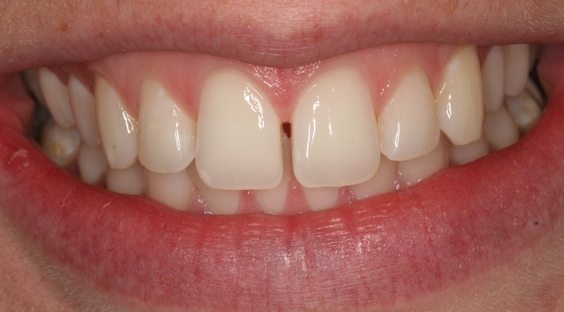Many people have gaps in their smiles, whether several spaces throughout or a single noticeable opening.
Gappy smiles can be caused by several reasons:
- Too small teeth
- Missing teeth
- Tongue thrust — the tongue pushes out on front teeth or in between top and bottom teeth when the person swallows, creating pressure over time that causes spaces to occur between the teeth.
- Low Frenulum attachment in the mid-line, causing a gap between front central teeth.
The traditional method for dealing with such imperfections has been through the use of orthodontics, which is suitable for patients who don’t mind a little waiting, and are happy that this option gradually pulls teeth into their correct alignment, simultaneously making gaps disappear and correcting one’s bite.
However, many patients would like an option that doesn’t require the time and commitment of orthodontics. For these individuals, porcelain veneers can be the ideal choice, as it can close several spaces and redesign the entire smile at the same time.
Tooth Bonding for Gaps Between Teeth
Tooth bonding may be used to make teeth larger as well. Several layers of bonding material are applied to the surface of your tooth until it is the desired size and shape, and then the composite is cured to a hardened state. If gaps are too large to be corrected with tooth bonding, Dr. Tehranian may recommend porcelain veneers.
Composite bonding, also known as cosmetic bonding, is one of the most basic yet effective cosmetic treatments. In just a single visit your smile can be transformed without the need for anaesthetic, drilling or lengthy dental appointments.


Your cosmetic dentist will initially discuss the areas of concern you want to address, after which he will choose a shade of composite material to match your natural teeth and mould the material to improve the state of the teeth. The area to be treated will be thoroughly cleaned to remove any debris, ready for the special gel that is then applied. The dentist will shine an intensive light beam on the tooth to set the bonding agent. In many cases, bonding material is applied in thin layers to recreate the look of natural teeth.
The application of composite bonding is generally for a single tooth or a small number of teeth, rather than an entire arch. Composite bonding works best on small areas as the bonding is not strong enough to work over large areas.
Composites made to a paste-like consistency so that they can be sculpted to the proper shape. They contain different pigments that can be matched to your tooth colour, and they also come in varying degrees of transparency and are usually made so that they can be polished to a high gloss. This composite is applied to your tooth. Often several layers of different shades and translucencies need to be used in order to duplicate the depth of colour and shifts that occur in natural teeth.
As Cosmetic Tooth Bonding is a very technique sensitive procedure, it is recommended that you only go to a dentist with a strong artistic inclination and extensive post-graduate training in cosmetic dentistry. The teeth bonding techniques required to do composite bonding well are not required training of general dentists. And very few dentists have the creative talents and competence needed. Call us today on 01772 – 726932 to book cosmetic consultation for dental bonding.
